Contents
If your cherry tree has never been pruned before, don’t worry—it’s never too late to start! Pruning may sound intimidating, but it’s a simple and rewarding part of tree care, especially for cherry blossom tree. The goal is to help the tree grow stronger, healthier, and more beautiful over time.
Start by removing any dead, damaged, or diseased branches. These take up energy and can harm the rest of the tree. Next, look for any branches that cross or rub against each other—cut one to avoid future damage. It’s also a good idea to thin out the center of the tree a little, so sunlight and fresh air can reach all the branches.
Use clean, sharp pruning shears, and make your cuts at a slight angle just above a bud or branch joint. Prune during late winter or early spring, before the tree starts to bloom. This timing helps the tree heal quickly and encourages beautiful spring blossoms.
Remember: less is more. Don’t try to do too much at once. With regular, gentle pruning each year, your cherry tree will thrive and continue to be a stunning highlight of your garden.
With regular, gentle pruning each year, your cherry tree will thrive and continue to be a stunning highlight of your garden — just like how Cherry Blossom Trees Grow in California with the right care and conditions.
Timing is everything when it comes to pruning a cherry blossom tree. The best time to prune is late winter to early spring, just before new growth begins. During this period, the tree is still dormant, which helps reduce stress and allows it to heal quickly. Pruning at this time also gives the tree a clean shape before it starts to bloom, encouraging healthy branches and more blossoms.
Avoid pruning in the fall, as cuts made late in the year can invite disease or damage from cold weather. For flowering cherry trees, it’s also safe to do light pruning in early summer, right after the blossoms have fallen. This helps manage the shape without removing next year’s flower buds.
In short, prune your cherry tree when it’s quiet—either before it wakes up in spring, or right after its floral show is over.
The ideal time to prune cherry blossom trees is late winter to early spring, before new buds begin to open. During this dormant phase, the tree isn’t actively growing, which means it’s less vulnerable to stress and infections. Pruning at this time gives the tree a fresh start, allowing it to direct energy toward healthy new growth and vibrant spring blooms.
If you miss this window, you can still do light shaping in early summer, just after the flowers have faded. However, avoid heavy pruning in autumn or late summer—this may weaken the tree and reduce next year’s blossoms.
By choosing the right time, you not only keep your tree healthy but also enjoy a fuller, more beautiful bloom season year after year.
Yes, you can prune a flowering cherry tree in winter—but timing matters. The safest period is late winter, when the tree is still dormant but just a few weeks away from spring. This is the perfect time to remove dead or damaged branches and gently shape the tree without interfering with new growth.
However, avoid pruning in early or mid-winter, especially during very cold spells. Fresh cuts may heal slowly in harsh weather, making the tree more vulnerable to disease or frost damage.
If you wait until late winter, your cherry tree will have time to recover before it begins blooming—setting the stage for a healthy and beautiful spring.
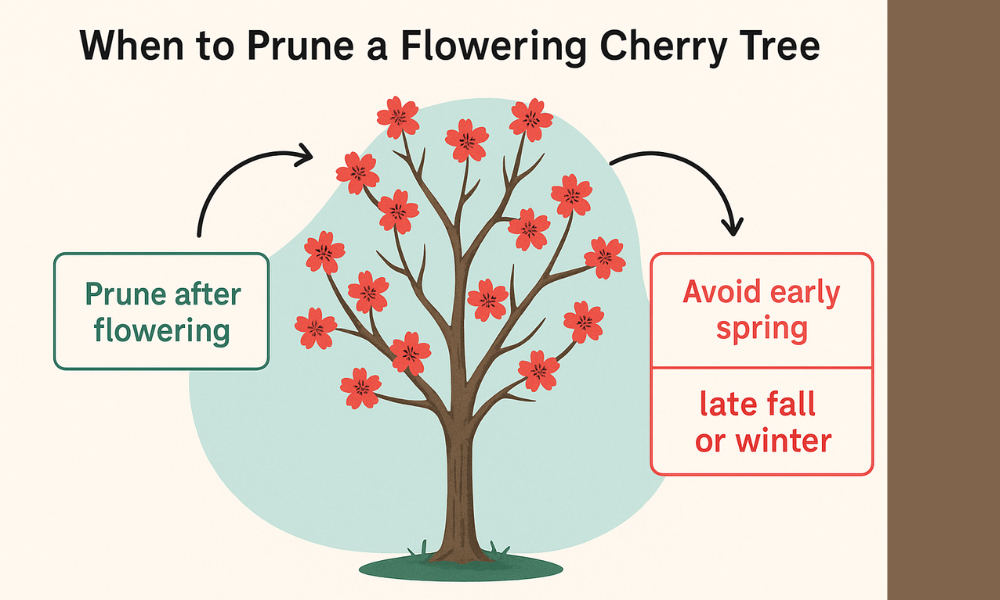
The best time to prune a flowering cherry tree is right after it finishes blooming in spring. This timing allows you to shape the tree without cutting off next year’s flower buds, which begin to form shortly after the blossoms fall. Pruning too late in the summer or fall may reduce the number of flowers the tree produces the following spring.
Avoid pruning in early spring before flowering, as this removes the buds that are just about to bloom. Also steer clear of late fall or winter, when cuts can heal slowly and expose the tree to disease.
By pruning soon after flowering, you can encourage a balanced shape, remove any dead or damaged branches, and keep the tree healthy and full of color for years to come.
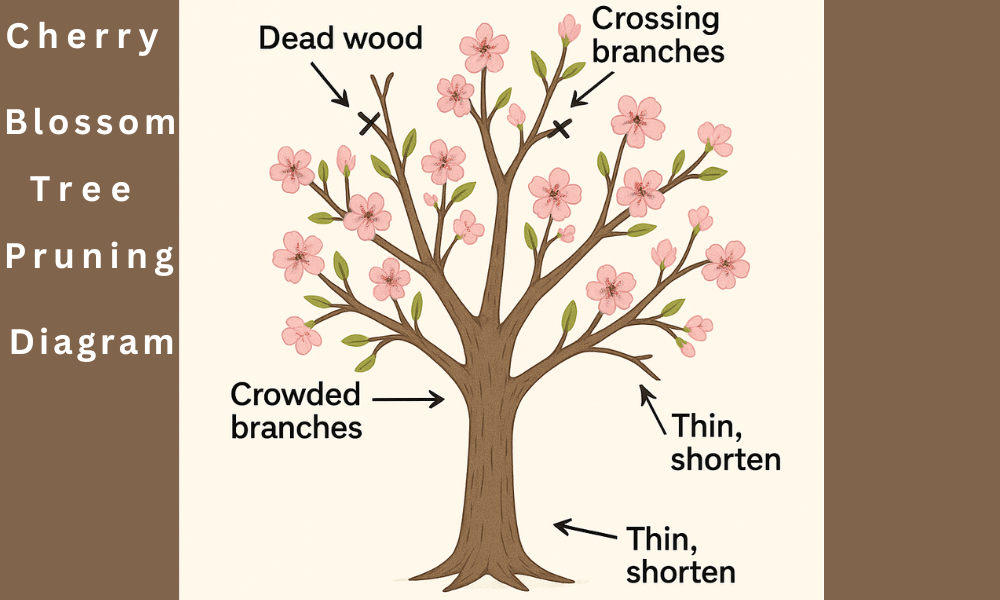
A pruning diagram is a great visual tool—especially if you’re new to gardening. It shows where and how to make cuts on a cherry blossom tree to improve its shape, airflow, and flowering. Most diagrams highlight key areas to focus on: dead wood, crossing branches, crowded growth, and the tree’s central structure.
When looking at a pruning diagram, you’ll often see arrows pointing to branches that should be removed, thinned, or shortened. The goal is to open up the canopy so sunlight and air can reach all parts of the tree. This helps prevent disease and encourages strong, healthy blooms.
If you’re unsure where to start, following a basic pruning diagram can give you the confidence to make smart, clean cuts—and keep your cherry blossom tree growing beautifully for years to come.
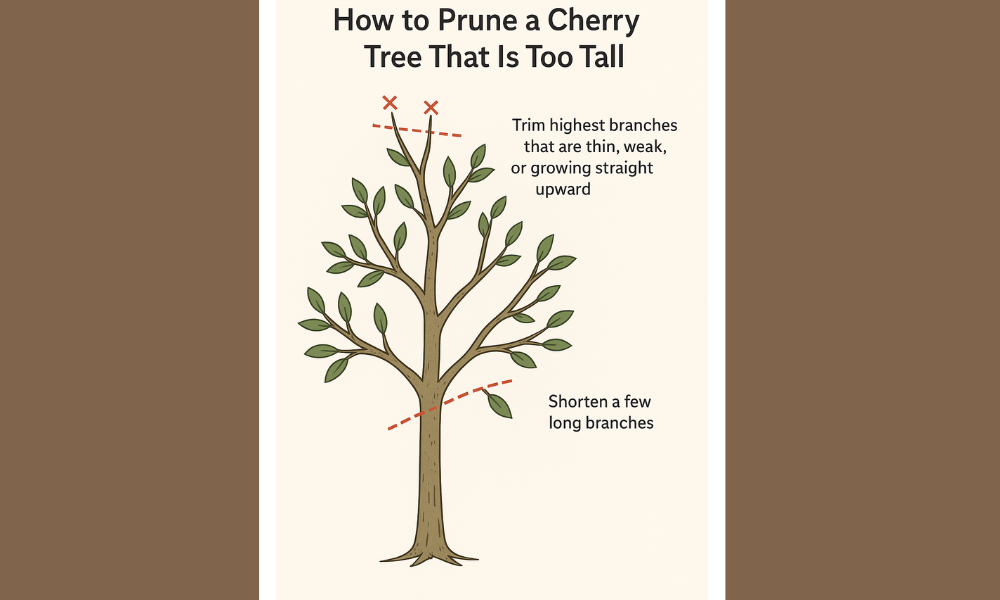
If your cherry tree has grown too tall, pruning it can help bring it back to a manageable size while also encouraging healthier growth. The key is to go slow and avoid cutting too much at once—removing too many branches can stress the tree and reduce next season’s blossoms.
Start by identifying the highest branches that are thin, weak, or growing straight upward. These vertical shoots, often called “water sprouts,” can be trimmed back to a lower, outward-facing bud or branch. Next, focus on shaping the top by shortening a few long branches, but always cut just above a healthy side shoot.
Try not to reduce more than 20–25% of the tree’s canopy in one year. If the tree is extremely tall, it may take 2–3 seasons to bring it to the desired height. Patience is key—each year, you’re helping the tree adapt and become more balanced without shocking its system.
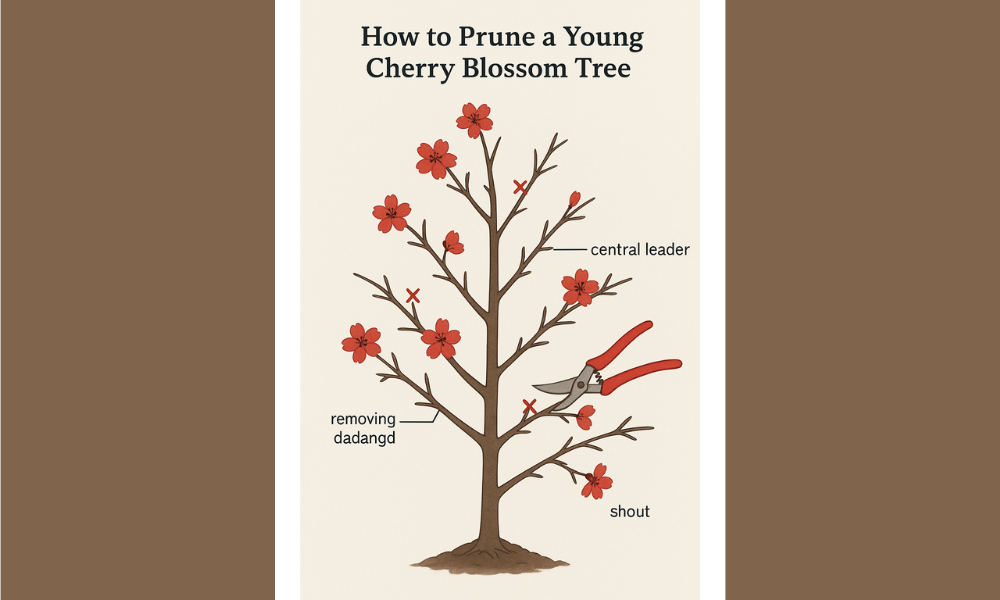
Pruning a young cherry blossom tree is all about building a strong foundation for healthy growth and future blooms. In the first few years, your goal is to shape the tree’s structure—not to control size. The best time to prune is late winter to early spring, while the tree is still dormant.
Start by removing any dead, damaged, or downward-growing branches. Then, select one central leader (main trunk) and a few well-spaced side branches to keep. Trim away any small shoots that grow straight up or toward the center of the tree. This helps light and air reach every part of the tree, keeping it healthy and balanced.
Don’t overdo it—young trees need their energy to grow. A light annual pruning helps guide the shape without slowing down development. With a little care, your young cherry blossom will grow into a beautiful, flowering centerpiece in your garden.
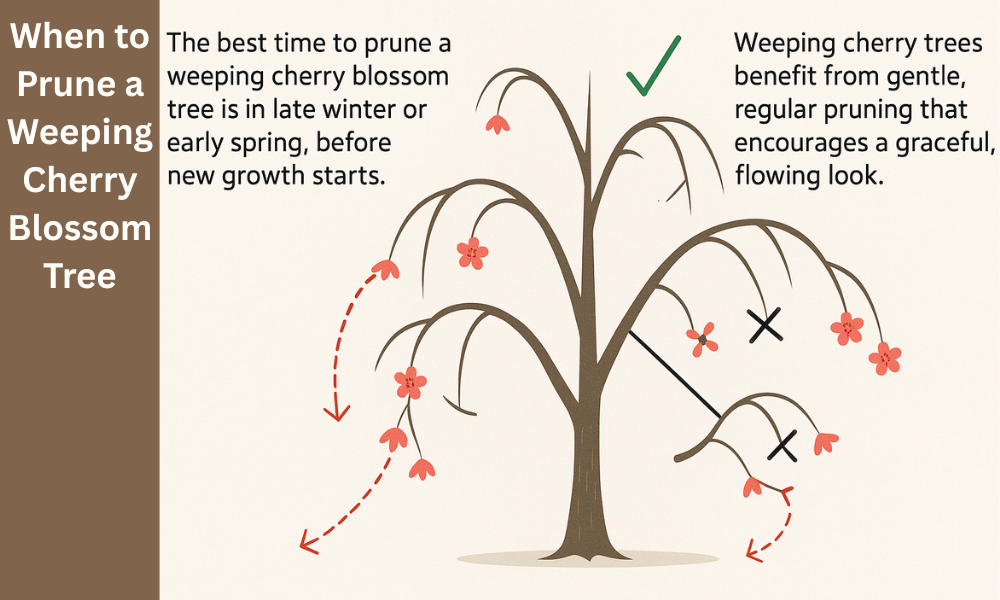
The best time to prune a weeping cherry blossom tree is in late winter or early spring, before new growth starts. During this dormant period, you can clearly see the tree’s structure, making it easier to shape without damaging new buds. Pruning at this time also helps the tree heal faster and bloom more beautifully in spring.
If your tree is already flowering, wait until early summer, just after the blossoms have fallen. This is a safe time for light pruning to maintain its weeping shape. Avoid cutting in fall or late summer, as this can reduce next year’s blooms and make the tree more prone to disease.
Weeping cherry trees benefit from gentle, regular pruning that encourages a graceful, flowing look. Focus on removing any dead or crossed branches and keep the bottom of the canopy tidy so the “weeping” form stays soft and elegant.

Mahmuthan Azaklı is an actively engaged SEO consultant in the digital sphere. Based at Trabzon-headquartered Fennes Home, he stands out for his expertise in search-engine optimization. Having collaborated with companies across various industries, Azaklı continually sharpens his skills in web design, web development, and SEO strategy, delivering comprehensive digital solutions to clients. His work focuses on boosting digital visibility, driving organic traffic, and executing effective technical SEO initiatives.
